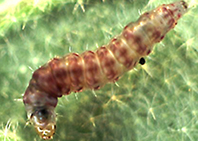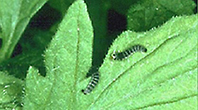
Pheromone Chemicals
Manufacturers of Pheromone Traps & Lures





Keiferia lycopersicella
(Tomato Pinworm) - The tomato pinworm is a small, micro lepidopteran moth that is often confused with closely related species, which have similar habits.
Life cycle
Eggs are laid singly or grouped in twos and threes on the host-plant foliage. The eggs are opaque to pale yellow when laid, but turn orange before hatching. The first instar larvae spin a tent of silk over themselves and tunnel into the leaf. Further feeding results in a blotch-like mine usually on the same leaf. The third and fourth larval stages feed from within tied leaves, folded portions of a leaf, or enter stems or fruits. Mature larvae abandon the host and form a loose pupal cell of sand grains near the soil surface. The adult emerges from this pupal cell two to four weeks later. Although the life cycle is lengthy, generations overlap and infestations quickly mount to damaging proportions. Seven or eight generations or more per year can be expected.
Host plants
Plants of the nightshade family, (Solanaceae), are the preferred hosts of pinworms. Tomato, is infested most commonly, but eggplant, and potatoes, also are attacked.
Damage
Symptoms: The larva causes mines on the leaves, visible mainly on the upper surface. These mines widen during the second larval instar forming a translucent blotch. As the larva matures the leaf is distorted and spun together, flowers are also affected in this way. In fruits the larval entry hole can be detected, and galleries can be seen just beneath the surface; rot may also occur.
Management
Several sanitary measures should be followed because infestations often result from shipment of pinworms in picking containers, crates, infested fruit or seedlings, and from populations perpetuated on plants left in fields after harvest or left in seed flats or compost heaps. The precautions include use of transplants that are free of eggs and larvae when set in the field, and the destruction of all plant debris in fields after harvest
ETL for Keiferia lycopersicella is 15–20 No’s of moths per trap per day.
Use 10-12 No’s Pheromone Traps per acre from 15 days crop stage to control pest at early stage.
Trap canopy should be placed one feet above crop canopy to achieve optimum catch.
Recommended for: Tomato and Potato.
© 2020 Pheromone Chemicals. All Rights Reserved | Powered by: Raviteja Designs